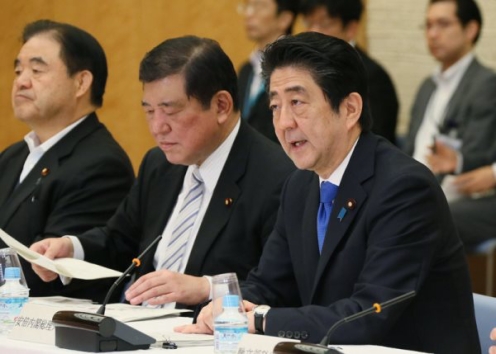
Image: japan.kantei.go.jp
This month the Government of Japan published its Plan for the Dynamic Engagement of All Citizens. As well as noting progress made under its signature ‘Abenomics’ growth strategy, the Plan goes some way towards detailing measures the government intends to put in place in order to tackle Japan’s declining birth rate and ageing population. To this end, it envisages three new ‘arrows’ as the roadmap towards a “society where all citizens are dynamically engaged”, these being a robust economy, childcare support and social security.
Unsurprisingly, on the back of the recent G7 Ise-Shima Summit, one key theme of the growth strategy (additional to childcare support and measures to alleviate reliance on the working age population in elderly care) is the idea of “regionally cohesive societies” (which brings together the goal of regional revitalisation with the new measures around child and elderly care), in particular the promotion of tourism in the regions (including MICE and greater adoption of PPP projects). Here we outline some of the local government-related measures detailed in the Plan.
Realisation of Regional Cohesive Societies
To realise “regional cohesive societies” where all people, including children, the elderly and people with disabilities, can generate their local communities, their way of life and their motivations together, mutually enhancing each other. Towards this goal, the Government will develop local communities where all local residents have their own roles and play active roles like themselves, mutually supporting each other and not being split into a supporter side and a recipient side. By doing so, it will build a scheme where people can lead their lives, collaborating with local public services including welfare and mutually helping each other. Also, it will foster a donation culture and promote collaboration with NPOs and the utilisation of private funds.
Realising Japan as a Tourism-oriented Advanced Country
Based on A Tourism Vision to Support the Future of Japan and others, and with the goals of increasing the annual number of foreign visitors to Japan to 40 million people by 2020 and 60 million people by 2030 and increasing the consumption by foreign visitors to Japan to 8 trillion yen by 2020 and 15 trillion yen by 2030, the Government will carry out comprehensive and strategic measures towards the realisation of Japan as a tourism-oriented advanced country through government-wide and government-public collaborative efforts. Through this, it hopes to be able to develop an extensive industry of tourism as a field in which all citizens will be dynamically engaged.
Specifically, in order to maximise the attractiveness of tourism resources and make them serve as a foundation for revitalising regional economies, it will open appealing governmental facilities and promote the conservation, branding and utilisation of tourism and cultural resources such as national parks and farming and fishery villages with beautiful landscapes.
In addition, with the aim of innovating the Japanese tourism industry, increasing its international competitiveness, and setting it as one of the key industries of Japan, it will take such measures as revising tourism-related regulations and systems, developing human resources in tourism management, establishing and developing world-class DMOs, enhancing promotion activities targeting people in Europe, the United States and Australia as well as wealthy people, and relaxing visa requirements for strategic purposes.
Furthermore, it will promote the development of an environment where all tourists will be able to enjoy travelling in Japan comfortably without stress, by taking such measures as promoting the holiday reforms (e.g. encouraging more workers to take annual paid leave and promoting staggered holidays) through the labour-management efforts, speeding up the immigration procedures through the use of advanced technology, improving the accessibility of communication and transportation services, and introducing universal design in tourism areas and transportation facilities.
Facilitating Regional Reinvigoration
Local areas most seriously suffer from depopulation and the problem of falling birth rate and the ageing population. Measures need to be taken urgently to solve these problems for the purpose of achieving the dynamic engagement of all citizens. The Government will promote efforts utilising Japan’s properties including tradition, cultures, ties between individuals and the spiritual richness of Japanese people.
Based on the Overall Strategy on Vitalizing Local Economies (revised in 2015) and Basic Policies for Overcoming Population Decline and Vitalizing Local Economies in Japan 2016, it will make efforts to overcome the problems of population decline and shrinking local economies by further promoting Local Abenomics, facilitating urban people’s moves to and settlement in regional areas, changing working styles in accordance with circumstances of each area, and creating collaborative urban areas, thereby correcting the excess concentration of population in the Tokyo Metropolitan area, enabling young people to have jobs and families, and resolving problems unique to each local area.
The Plan can be downloaded in full here (PDF).
Related:
Forum for Consultations between the National and Regional Governments (May 2016)
Council on National Strategic Special Zones (May 2016)
National Council for Promoting the Dynamic Engagement of All Citizens (May 2016)

